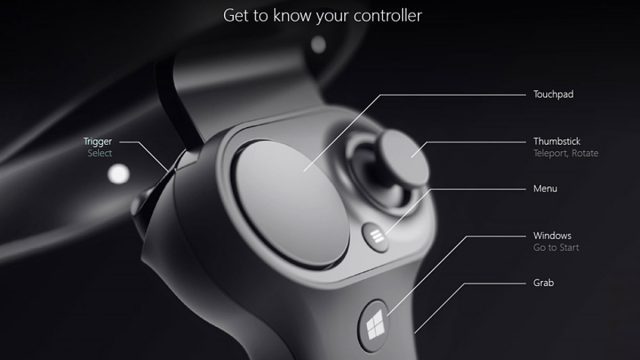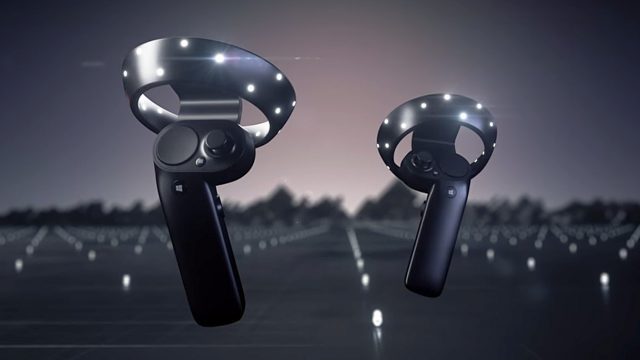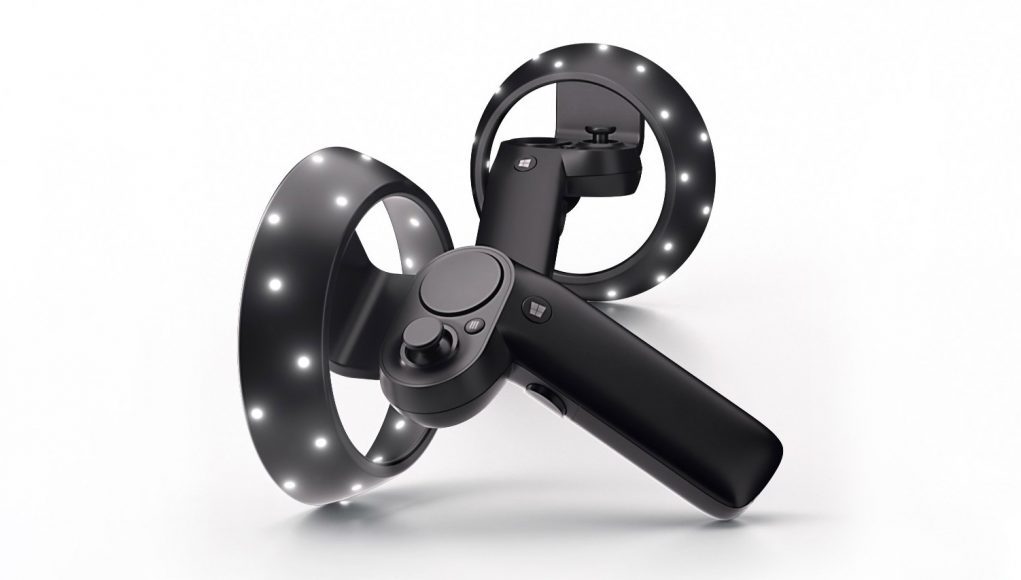Microsoft debuted the lengthily-named “Windows Mixed Reality motion controllers” back in May, but until now we haven’t had a chance to actually try them out. During a recent meeting with Microsoft in San Francisco, I got to try the VR controllers for the first time paired with the Acer Windows VR headset.
Microsoft’s VR controllers are designed to let you reach into VR and interact naturally with the virtual world. With both a trackpad and a thumbstick, they look like a crossbreed of the Oculus Touch controllers and the Vive controllers.
In addition to the trackpad and thumbstick, there’s also a menu button and a Start button, as well as a grip button along the handle. The big circular parts on the front contain an array of LEDs which provide bright markers for the headset’s on-board cameras to detect and track. Microsoft tells us that the shipping version of the controllers will indeed use visible-light, just like we’ve seen in renderings and promo videos. (Microsoft didn’t allow any pictures of the controllers during my hands-on time).
Buttons and Inputs

Grabbing the controllers for the first time, they didn’t feel quite as elegant as either Touch or the Vive controllers. The odd side-by-side trackpad & thumbstick arrangement is useable, but seems to effectively put neither of the two in an ideal position for your thumb. The grip button is indeed a binary button (rather than being pressure sensitive), and doesn’t feel so much like a “grab” as it does a clicky button press with your palm.
Ergonomics
Though they resemble Touch with their ring-shaped tracking appendages, the Windows motion controllers are actually noticeably larger and clunkier thanks to the placement of the tracking rings, which don’t encompass your hand like Touch, making the controllers easier to bump together, especially when their physical outline is hidden in VR.
The shape of the rings is necessary though, as they need to present a substantial surface area from which the headset’s on-board cameras can track their movement. Though I was using the Acer dev kit headset, our understanding is that these controllers will work with any of the soon to be released Windows VR headsets (all of which feature on-board cameras).
Pros and Cons of Inside-out Controller Tracking

This method of controller tracking differs from both the Rift and the Vive in that it’s the cameras on the headset which are watching the controllers to track their movement (which is called ‘Inside Out’), whereas the Rift and Vive both use external sensors to track their controllers (called ‘Outside In’).
The upside to this approach is that you don’t need to set up any external trackers, but the downside is that the controllers must always be in view of the headset’s front-facing cameras to be properly tracked. Thankfully, the size of the tracking volume felt reasonable; for basic use (like reaching out in front of me to grab virtual objects), I didn’t feel like my reach was artificially limited by the camera’s field of view.
Outside of the Box Tracking
And for times when your hands will go out of the camera’s field of view, Microsoft is doing its best to compensate. When that happens, the system relies purely on the controller’s on-board IMU to estimate positional movement until it reappears in the camera’s view. This works well enough for quick jumps in and out of the camera’s view, but after a second or two, the IMU-only tracking estimation is too unreliable, and it appears that the system will eventually freeze the location of the controllers in the air and only feed them the rotation data from the IMU, though they snap quickly back into their proper place as soon as they’re brought back into view. It remains to be seen how much this limitation (the need to be seen by the front-facing cameras) will impact different VR games and apps, and how effectively it can be designed around.
Tracking Accuracy
As for the tracking accuracy when they are in sight of the camera, I did see some jumpiness here and there—especially if I was rotating my body while moving the controllers—but on the whole they seem entirely usable, and (in my short time with them thus far) to be more accurate than the PlayStation Move controllers.
As part of my testing, I played Arizona Sunshine (2016), and found that guns were steady when I held them out in front of me and aimed down their sites; I didn’t have any trouble landing zombie headshots. Granted, for inside-out controller tracking, holding a gun up in front of me to aim is pretty much the best case scenario—I’m curious to see how other common input modalities hold up (like shooting a bow and arrow or swinging a sword).
The occasional jumps didn’t present much issue in a shooting scenarios, but for more precise uses, like VR drawing, painting, and animating, it remains to be seen if those jumps will cause any usability issues.
– – — – –
Microsoft says that the Mixed Reality motion controllers will be bundled with Windows VR headsets starting at $400 this holiday.
Got questions about the Mixed Reality controllers? I’ll be taking questions in our comment section below.







